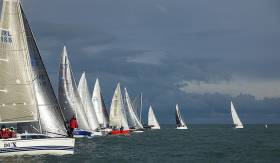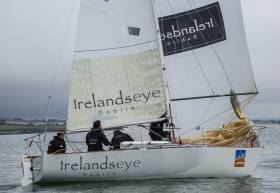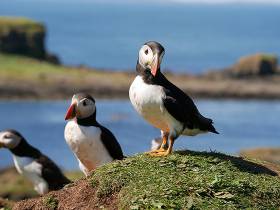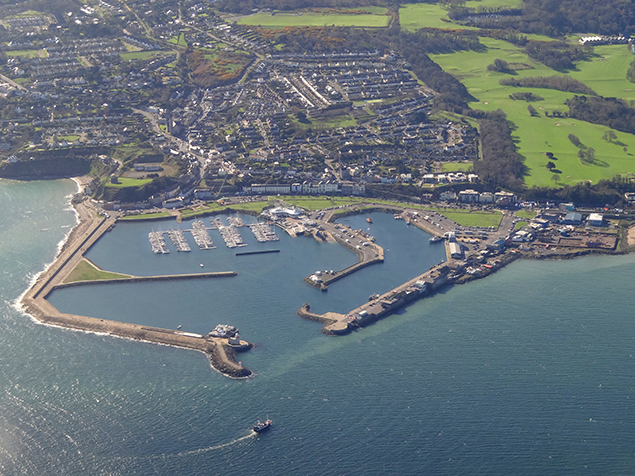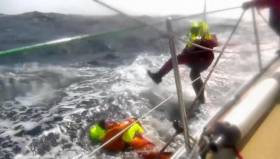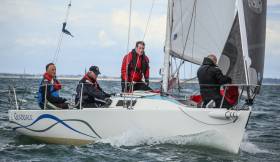Displaying items by tag: Howth Yacht Club
Lobster Pot Snag for Howth Yacht Club's BAM! in Middle Sea Race
Howth Yacht Club crew man Anthony Doyle reports from Conor Fogerty's Jeanneau 3600 BAM! on the second day of the Middle Sea Race Race.
'We're just through the straits of Messina at approx 1530, we have what you can only call a mixed bag of a race.
Following a very light wind start in Valletta Grand Harbour we found ourselves with plenty of time to make up after the beat to Mark 2. Then the course brought us north to the South eastern side of Sicily where BAM! started hauling and passing out the competition.
Unfortunately we snagged a very complex lobster pot off Sicily which cost us at least an hour and one of the crew had to dive down to untangle the mess.
This meant that our competitors got away on different breeze but we are now reaching towards Stromboli with the A2 up doing 10 knots and a course of 330 magnetic and hope to make up some lost time.
Hopefully this is a race of many starts, and we have had ours... The skipper and crew are in great spirits and already looking forward to the next one pot wonder Paddy Gregory will rustle up for dinner this evening.
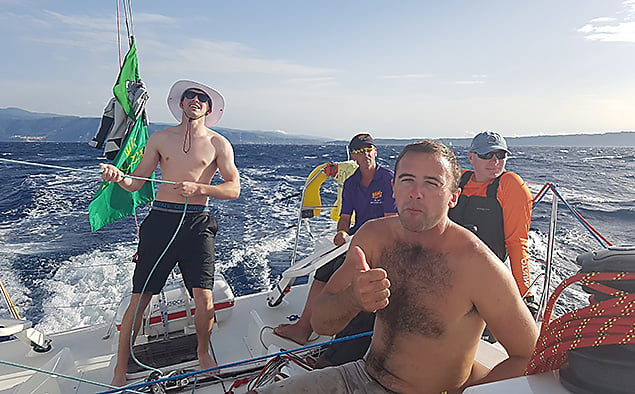 Conor Fogerty's BAM! crew have the wind behind them on day two of the Middle Sea Race. The Irish Jeanneau 3600 is racing in division IRC six with a full Howth Yacht Club crew including Simon Knowles, Paddy Gregory, Sam O'Byrne, Rob Slater and Anthony Doyle
Conor Fogerty's BAM! crew have the wind behind them on day two of the Middle Sea Race. The Irish Jeanneau 3600 is racing in division IRC six with a full Howth Yacht Club crew including Simon Knowles, Paddy Gregory, Sam O'Byrne, Rob Slater and Anthony Doyle
As Afloat.ie reported previously, Fogerty's is racing in division IRC six with a full Howth Yacht Club crew including Simon Knowles, Paddy Gregory, Sam O'Byrne, Rob Slater and Anthony Doyle. As Afloat.ie readers will recall, the doughty Irish offshore campaigner took a class win in February's RORC Caribbean 600 race.
Fogerty arrived into the Grand Harbour in Valletta last Tuesday. In the last 12 months, Bam has been sailed from Howth to the Canaries, then did the ARC race to St Lucia, then the Caribbean 600 race in February, then Conor sailed solo to the Azores, delivery from Azores back to Howth, then the Round Ireland Yacht race in June, then to the Solent for the Fastnet solo race, then the new RORC IIe D’Ouessant Race, then the Cowes to Cherbourg race and just now a delivery from Southampton to Malta. After the Middle Sea race, the boat will be wintered ashore in Malta until next spring year when she returns home.
Organised by the Royal Malta Yacht Club, the 2016 Rolex Middle Sea Race will start at 11:00hrs (CET) on the 22nd October in the spectacular Grand Harbour, Valletta, Malta.
ISORA sailors Liam Coyne and Brian Flahive are back onboard the Maltese J122 Otra Vez skippered by owner Aaron Gatt Floridia, who has sailed in Ireland's Dun laoghaire to Dingle race. It will be Coyne's fourth Middle Sea on Otra Vez. 'This will be my seventh Middle Sea race and really feeling good about this one' Coyne told Afloat.ie. Coyne managed a class win in 2014 and has previously been sixth time overall.
Also racing is INSS sailor Kenneth Rumball as part of a Maltese crew onboard the Xp44, Xpact. Rumball previously raced on Xpact in 2014 with other Irish sailors Andy Boyle, Philip Connor and Barry Hurley to second overall and first in class three onboard this X-Yacht. Hurley is back on board this year and joining them is Shane Divney of Howth Yacht Club coming back from GC32 Circuit. Laura Dillon of HYC is on Winsome. Dublin's Conor Kinsella, a co-skipper on Lynx in this year's Round Ireland, is sailing on Xpedite.
London–based Royal Irish Yacht Club sailor Niall Dowling is listed on the crew of Pata Negra, the Lombard 46 skippered by Giles Redpath
Single Final Race to Decide Howth Yacht Club Autumn League
Following the cancellation of two days racing in mid-series due to adverse weather, this year's MSL Park Motors Mercedes-Benz Autumn League competitors enjoyed two races this Saturday, affording the competing teams a real opportunity to challenge the leaders in all 8 classes. Aided by an ever-increasing wind forecast, the race management teams chose to run two windward-leeward courses for both inshore and offshore fleets. Multiple windward-leeward race starts are always a risky undertaking, but the HYC teams used their considerable experience to manage two races for each fleet within the time limit.
Having now completed 4 races, a discard now applies and allows competitors to accumulate their best 3 results before including next Saturday's last race of the six week series. The limited time to complete this week's two races made for very close and exciting racing with short legs and very busy mark-roundings. Boat handling was crucial as only seconds separated many of the classes in each race.
It was business as usual on the 'Offshore' course, with Pat Kelly's Storm winning the first race but their DNC (Did Not Compete) in the second race leaves it all to play for in Class 1 IRC. It would appear that Stephen O'Flaherty's immaculate Spirit 54 Soufriere will certainly be a contender for the ECHO prize in that class next week.
A first and second place for Dave Cullen and his team on Checkmate guarantees that the Cullen/Biggs Half-Tonner will collect the Class 2 IRC trophy next week and meant that they could pack the boat into its winter storage a week earlier than anyone else. Second place will certainly go the last race, with two other Half-Tonners The Big Picture and King One along with Richard Colwell and Ronan Cobbe's Fusion all contending for the remaining spoils. A late-season run of form sees Darren Wright and Rick DeNeve's Kodachi 'neck-and-neck' with Dux and Harmony for next week's overall ECHO result.
The application of discards certainly condenses the leaderboard in Class 3, which presents itself as anyone's game with one day to go. Always prominent at the top of the Autumn League scoresheet, Vince Gaffney's Alliance II will race the two K25 teams on their J24s Johnny Bravo and Scandal as well as Kahera and Fulmar Fever for the top prize. The fact that a 4th place IRC prize will be presented means that Fulmar Fever is also likely to be jousting for the ECHO trophy with Jonathan Wormald's Formula 28 Starlet.
The Harris/ Hughes team on their Beneteau Tiger are being hunted down by Dermot Skehan's Toughnut in Class 4, with Harry Byrne's Alphida only 2 points behind. This class is notable for the pedigree of its 'senior' racers, proving that skill and determination are more than a match for youth and enthusiasm in our sport! The ECHO prize might go to either Howard McMullen's Splashdance or Kieran Jameson's Changeling in a result that might replicate the event statistics of many previous decades.
An impressive string of wins in Class 5 means that Windsor Lauden and Steffi Ennis's Shamrock 28 Demelza is already guaranteed the trophy while Declan Gray's Sapphire and Vincent Lundy's Cheyenne lead the class for the ECHO prize and the Denis Wickham Trophy.
Nothing separates Gold Dust and Harlequin in the Puppeteer Class and it's very unlikely that the chasing boats (Trick or Treat and Yellow Peril) will manage to make an impression on the leaders, whose impressive results show them tied on 4 points each after 4 races. However in the Handicap division, the bookies won't be taking any money on Frank Dillon's Flycatcher whose results suggest a remarkable improvement in form within the 17-boat fleet.
Never a class to sit quietly, the Howth Seventeens emerged from a protest that saw just 6 boats scored in a race 2 weeks ago, and consequently many must have been glad to be able to apply their discard following the races this weekend. Two wins by the Turveys' Isobel puts their team at the top of the leaderboard, just ahead of Peter Courtney's Oona and Michael and Jane Duffy's Hera is a further 3 points behind. An effective class handicapping system means that the improved performances of Silver Moon and Eileen affords them the opportunity to compete for the Alphida Cup next week.
One of the most remarkable successes of this year's Autumn League has been the popularity of the 'Taste of Racing', a formula devised by Fergus O'Kelly and utilising the four ISA Sailfleet J80s with a selection of experienced HYC keelboat racers offering a tutorial to keen and prospective racing sailors that are new to the sport. Four of the clubs new J80s are also being chartered by members and are competing in Class 2.
The race management team have confirmed that they will be running a single final race next week and remind competitors of the earlier first warning signal time of 13:00. There are still limited places available at the event dinner and bookings can be made by contacting the office at 01 8322141.
North Dublin actor Brendan Gleeson was at Howth Yacht Club last Thursday (6 Oct 2016) for the annual RNLI Ladies Lunch in aid of Howth RNLI. The sold-out charity event was attended by 150 local ladies and raised over €8,000.
When asked what motivated him to support the RNLI he responded, ‘The RNLI is an incredible organisation. I’m full of admiration for the work that they do. Many years ago I spent time filming on an RNLI lifeboat in South Wales, and it was a privilege to have the opportunity to get to know the crew well. Last year Howth RNLI was the busiest lifeboat station on the coast of Ireland. It’s an honour to be here today, and it’s great to live in Howth among a bunch of heroes’.
Mr. Gleeson, who is one of Ireland’s most prolific actors on stage and screen, is best known for his roles in The Guard, the Harry Potter films and Braveheart, happily mingled with the guests at the sold-out event, and patiently posed for numerous photographs and selfies.
He gave an insightful and thought-provoking speech about the life-saving work of the RNLI, and how the volunteer crewmembers and the people they rescue are so interlinked with local communities. He spoke about the lessening of anxiety and sense of reassurance a community has, knowing that the lifeboat will come to their aid if needed. Mr. Gleeson also mentioned a line from a Seamus Heaney poem about the economy of kindness, and remarked on the dignity the lifeboat crews show to those in their care. He praised the life-saving volunteers and described them as noble, selfless, strong minded and compassionate, who exhibited Navy discipline with maximum efficiency and safety while maintaining a sense of mutual respect and comradeship for their crew mates.
Rose Michael, Howth RNLI Fundraising Chairperson, commented, ‘
We are thrilled to have Brendan here today. He has a deep respect and genuine understanding of the sacrifices and challenges that our volunteer lifeboat crewmembers face every time they are called out on a rescue. We greatly appreciate that he has taken time out of his very busy schedule to be here with us. The funds today raised will go towards the costs of on-going training and crew kits for the lifeboat crew ’.
Howth Yacht Club's Team 'Ireland's Eye Kilcullen' Graduate from the K25 Squad in Style
Whatever about all the other sailing around Howth Yacht Club, there are few who would dispute that one of the biggest HYC stories this year is the success of this J24 team.
Following their unprecedented success over the past months and years, the Ireland's Eye Kilcullen team threw a typically 'understated' celebration in Howth Yacht Club last Saturday night. Many of this team were founder participants in the K25 (under 25) programme when it was initiated in 2009 and now see themselves not only as successful graduates, but they've also developed and set the standard at the very highest level for those youth sailors from Howth following behind them.
In an extraordinarily short few years to the end of August this year and in addition to their numerous regional titles, the Ireland's Eye Kilcullen team held J24 National titles, ICRA National title, Match Racing National title (with former team member Ryan Scott), twice J24 European Under 25 winners, European IRC silver medal and won J24 European Championship bronze recently. Their last spectacular accomplishment in retaining their J24 National title in Dun Laoghaire recently seemed to slip past most of the sailing press's notice, where they sailed a flawless national championship series to win the title with seven straight race wins.
Most of this team will now be stepping down to make way for the next aspiring group of teenage and youth sailors motivated to replicate their success. As the remainder of the team now reaches 25 years of age, the youngest team member (Cian Manley) is empowered with forming and bringing one of the next teams through.
 Cian, Gordon, Sam and Cillian presenting Brendan and Paul O'Sullivan of Ireland's Eye (2nd and 4th from left) with a framed momento from their highly successful year Photo: HYC
Cian, Gordon, Sam and Cillian presenting Brendan and Paul O'Sullivan of Ireland's Eye (2nd and 4th from left) with a framed momento from their highly successful year Photo: HYC
So what happens in the lives of these guys next? It was always possible that the K25 initiative would seed opportunities for those wishing to join the professional sailing circuit and Luke Malcolm seems to have relished this prospect, as he's currently spending the remainder of this year doing many of the RYA accreditation modules in the south of England. In tactician and sport science graduate Gordon Stirling, the K25's loss is Ulster Rugby's gain, because 'Gordo' is now working with them as Strength and Conditioning Coach. Having been one of HYC's youngest Senior Instructors just a few short years ago, helmsman Cillian Dickson will now be applying his time to concentrate on studying for his Actuarial Science Degree. The final member of the 'retired' team is Sam O'Byrne, who's own 'DropChef' business with another former K25 member (Ryan Scott) will undoubtedly flourish under the Howthman's relentless energy.
Acknowledging the support given to the squad since it's inception, the guys were quick to thank The gift to Ireland's Eye Knitwear included gold, silver and bronze medals won by the team. The gift to Ireland's Eye Knitwear included gold, silver and bronze medals won by the team their sponsors including local knitware company 'Ireland's Eye' - presenting Brendan and Paul O'Sullivan with a specially framed photo set integrated with gold (ISA National J24 title), silver (IRC Europeans) and bronze (J24 European) medals. In addition to hosting dinner in the club for the sponsors, they invited K25 mentors Brian McDowell and Fergus O'Kelly and former HYC Commodore Brian Turvey, to thank them and the club for their support of this hugely successful youth initiative. The team was also quick to thank coach Graeme Grant and others such as Paddy Gregory and Ian Malcolm for their help with logistics.
Brian Turvey praised the team for the way in which they applied themselves and developed as an extraordinarily capable force not just in terms of race results but also as ambassadors for Howth Yacht Club.
With the provision of three J24 keelboats (by Enda O'Coineen and Brian McDowell) and access to the HYC's five new J80s, the K25 initiative continues to build and young sailors interested in developing their sailing skills in a team-focused environment with a view to high-performance achievement should contact [email protected] for further information.
Malahide's Mystique Shares Village's Story As Cradle of Irish Sailing Talent
While today’s galaxy of our top international sailing talent draws in its stars from many parts of Ireland to focus their energies and campaigns through a relatively few major centres, there was a time when one charming little estuary village north of Dublin produced much more than its fair share of exceptionally talented sailors. These included four Olympic sailing representatives, one of whom became a Silver Medallist. W M Nixon finds himself musing on Malahide while savouring the first race of the MSL Park Motors Mercedes-Benz Autumn League at Howth Yacht Club.
A good Autumn League race is sailing at its best, and last Saturday’s Mercedes-Benz League opener at Howth was vintage stuff, with 103 boats shaping up to their various starts on two course areas to round out a season of mixed weather and great achievements.
It was a classic ridge day between Friday’s heavy rain and Sunday’s rising gales, and it started as such a total meteorological punctuation mark between two vigorous weather systems that the more pessimistic anticipated an all-day calm. But with racing beginning at the very civilised time of 2.30 pm, a building south to southeast breeze was able to fill in sufficiently to provide excellent racing without continuing to strengthen or become cold to an uncomfortable level. And while clouds tried to develop, in time they melted away to enable that extraordinary September sunlight to work its magic again.
There’s such a variety of craft taking part in the Howth event year after year that, to do it justice and get the full flavour, Sailing-on-Saturday tries to bluff its way on board a completely different boat for the first race each September. So having done it last year with Algy Pearson on the Puppeteer 22 Trick-or-Treat for a classic One Design ding-dong, and the previous year with Stephen O’Flaherty with his exquisite Spirit 54 Soufriere and his energetic crew with their many permutations of asymmetrics and whatever, for 2016 everything pointed to a seriously veteran cruiser racing in one of the non-Spinnaker classes, and we struck gold with a quick phone call to Robert Michael.
He and his wife Rose have owned the Jeanneau Sun Fizz 40 Mystique of Malahide since 1989, and their 27 happy years with this very sensible Philippe Briand-designed sloop could provide a useful case study of how to organise and make best use of a good all round performance cruiser based in Ireland.
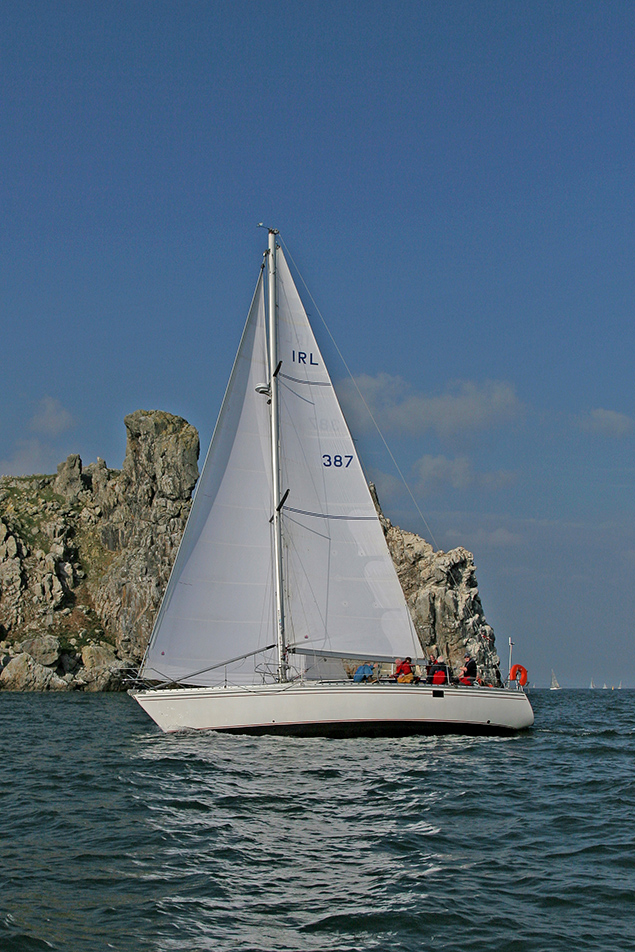 Malahide may be her spiritual home, but it’s at Howth she does much of her sailing. The successful Sun Fizz 40 Mystique of Malahide sails sweetly past the gannetry on The Stack at Ireland’s Eye off Howth. Photo: John Deane
Malahide may be her spiritual home, but it’s at Howth she does much of her sailing. The successful Sun Fizz 40 Mystique of Malahide sails sweetly past the gannetry on The Stack at Ireland’s Eye off Howth. Photo: John Deane
In her day, with production at a peak in Europe from 1980 to 1984, despite her relatively sedate looks the Sun Fizz 40 was deservedly a best-seller. So much so, in fact, that with her manageable size incorporating really good accommodation, it was said that when Jeanneau stopped building her, the moulds ended up in the US for another production run with some local mods for the American market.
That used to be dismissed as a waterfront myth. But a brief research session will reveal the existence across the Atlantic of the very familiar-looking O’Day 39 and O’Day 40, rendering further denial pointless. So those who were in on the early days of the Sun Fizz 40 were trend-setters in a trans-European trans-Atlantic movement, and when the first ones finally arrived in Ireland in 1982, delayed not by a lack of enthusiasm but by a sluggish economy and outrageous VAT rates on new boats, we eventually managed a boat test for Afloat Magazine.
But that wasn’t until September 1983, when there was no doubting the recently-acquired boat was second-hand. Yet it was worth the wait, for we liked this attractive “soncey big boat”. That favourable view came from Dick Brown of Weatherly Yachts in County Down, who had taken fifth overall in the 1982 Round Ireland Race in a new Sun Fizz 40 which had been the first one on the island, but had come into Northern Ireland ownership as the tax rates there weren’t so punitive.
As it happens, I did the Sun Fizz 40 test (it appeared in the magazine in November 1983) with the late Brian Hegarty, a leading example of those highly-accomplished offshore racing and serious cruising people who emerged from the sail training school which was Malahide. So it seemed entirely appropriate that when the actual boat we’d tested joined mainstream sailing in 1989, she became Mystique of Malahide, owned by Robert & Rose Michael.
 The Boat Test for the Sun Fizz 40 which eventually became Mystique of Malahide, published in the November 1983 Afloat magazine
The Boat Test for the Sun Fizz 40 which eventually became Mystique of Malahide, published in the November 1983 Afloat magazine
Those who are strangers to the ways of Fingal will find it curious that people whose sailing is so totally related to Howth seem to be completely intertwined with Malahide as well. Yet Robert was HYC Commodore in 1996-1997, while Rose is lead fund-raiser for the Howth Branch of the lifeboats to such good effect that she has twice been awarded the RNLI Gold Badge.
But their boats have long had “of Malahide” as an integral part of the name, and they wouldn’t dream of living anywhere else other than in their childhood home of Malahide, a place which has its own distinctive and distinguished sailing history.
However, as Malahide was a very small village within living memory, it took a while for its sailing infrastructure to catch up with the rest of Ireland. Initially it was just a boatyard with motley craft anchored off, including a couple of locally-based cruisers which sometimes found negotiating the very shoal sand bar at the entrance a trying business, for if you got it wrong there was no way of disguising the fact from your friends and neighbours.
Then a flotilla of Mermaids – some of them very successful - began to put Malahide on the sailing map, and in 1958 Malahide Sailing Club –now Malahide Yacht Club - came into being, one of the reasons being that the damming of the arches under the railway embankment across the upper estuary of Broadmeadow Water in order to prevent pillar erosion had given the local sailors an entirely new permanent sailing nursery to match the estuary and open sea sailing they could access below the embankment.
This facilitated the very rapid growth of a class of Enterprise dinghies – mostly home built - which provided another outlet for Malahide’s prodigious reserves of potential sailing talent, which had already put down a marker when the young Burrows brothers Richard and Johnny, with local lad Robin Hennessy as crew, had sailed their Mermaid the long haul to Wexford on a camping cruise in order to take part in the Mermaid Nationals, and duly returned with the trophy.
In fact the Burrows family – the children of noted Malahide-resident environmentalist, ecologist and extremely hard-working journalist George Burrows – exploded on the Irish sailing scene, and it was altogether typical of their style that Richard and Johnny did the Round Britain and Ireland Race in a little Shipman 28, newly-built in Limerick, at a time when they were also devoting much energy to building their working careers.
That was the Malahide way: work hard and sail hard. In a relatively short period it produced people like Robin Hennessy who won the Dragon Gold Cup in 1972 with such style that he was odds-on favourite for a Medal at the 1972 Olympics, only for a key crewmember to be struck down by a debilitating virus, and Robert Dix, who at 17 became the youngest-ever winner of the Helmsman’s Championship of Ireland in 1970, and represented Ireland in the Montreal Olympics in 1976.
However, it was 1980 when an Olympic Silver Medal finally came the way of Malahide with David Wilkins hitting the target in Tallinn. But while that is inevitably most remembered in this year of all years, there were many other outstanding achievements for the by-now rapidly growing estuary village, with another formidable talent emerging with the many successes – both inshore and offshore - of sailmaker Philip Watson, who like many others of Malahide, had first made his mark in Enterprise racing.
A remarkable pace had already been set when Robin Hennessy, crewed by Malahide clubmate Robert Michael, won the “British Helmsman’s Championship”, the Endeavour Trophy, in 1968 when it was sailed in Enterprises. Crewman Robert Michael – “Micko” to everyone – had learned his sailing in an unusual way. For though his family lived in the heart of Malahide, as a hospital doctor his father had a month’s clear leave every summer. Thus the family high-tailed it for the peak of the summer to the family place in Sneem in County Kerry, where young Robert learned about sailing through trial and error with a well-worn International 12 dinghy.
But by the age of 15 back home in Malahide, he was skippering a loaned Mermaid and that in turn led on to a stellar competitive sailing career that included racing with Sean Flood when they won the Irish Dragon Championship with Aletta.
The trouble with an idyllic sailing childhood such as Malahide provided in its developing days is that, in due course, adulthood intrudes. In time, Micko found himself becoming an item with near neighbour Rose Burrows, who had herself been a top achiever in Enterprises before taking off for a spell working in the big yachts in the Mediterranean. Having got together again, in order to make a living they each started complementary businesses in the security industry.
Robert found himself running his own company called Security Wardens. But as that was a 24/7 occupation, he needed the outlet of brief but guaranteed sailing relaxation, and it was provided with the winter-long Sunday morning Laser Frostbite series which had been inaugurated in Howth in 1974. It has been running every winter ever since, thereby giving the Howth club a continuous sailing programme since Opening Day in April 1974.
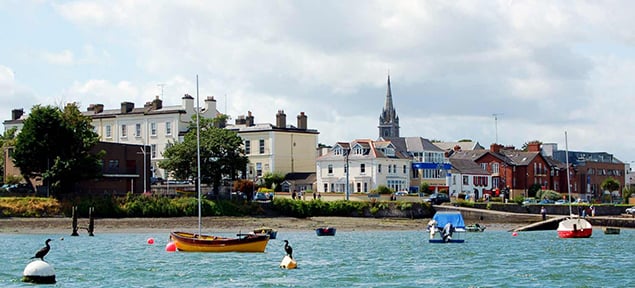 Malahide (above) has its own distinctive sailing history, yet many of its leading enthusiasts prefer to berth their boats at Howth seven miles away (below)
Malahide (above) has its own distinctive sailing history, yet many of its leading enthusiasts prefer to berth their boats at Howth seven miles away (below)
However, for the increasingly over-worked Robert Michael, inevitably he took on board the notion that Malahide was for living and shore life and going to work, but Howth was for sailing. So in 1982 – by which time he and Rose had a family with two daughters Lucy and Cathy, but they also had a new Moody 29, Mystique of Malahide – they naturally put their names down for a berth in Howth’s proposed club marina, for this was a clear ten years before anything like a marina was developed seven miles away at home in Malahide.
There were many other Malahide boat owners who did the same, so in that exciting but tricky time in the 1980s when Howth was in the process of transforming itself from a small local organization into one of the biggest clubs in the country with its own state-of-the-art marina, HYC Commodore Tom Fitzpatrick sensibly decided that the significant Malahide group in the club should be properly represented in its administration. He invited Robert Michael to let his name go forward for election to the committee, and the rest is history, as the Malahide man became a popular Commodore in 1996, while Rose in turn was taking over her mother Daisy’s key role in running the fund-raising for Howth Branch RNLI.
And although Malahide has had its own marina for 24 years now with the entrance channel marked and dredged, most of those Malahide sailors who took the big step of signing up for Howth marina back in 1982 have stayed on, and it would be impossible to overestimate the positive contribution the “Malahide crowd” make to Howth sailing.
In fact, they’re maybe getting the best of it, as their lives are more clearly defined. Leafy comfortable Malahide is for civilised day-to-day living, but rugged workaday fishing-minded Howth – only about twenty minutes away - is for boats and sailing. The Malahide folk know where they stand, whereas those of us who live on the Howth peninsula itself, and particularly right beside the harbour, can sometimes be a bit confused.
Certainly a sense of orderly progress and personal development is the abiding impression of the way things have worked out for Robert and Rose Michael. With the Moody 29 Mystique of Malahide, they not only day-sailed and cruised this comfortable boat, but they raced her with vigour in club and regional events with considerable success, which would have delighted designer Bill Dixon, for he knew the Moody 29 was a good ’un, but he didn’t realize she was quite that good.
Early each season with a pack of the lads, Robert would take the little Moody for a successful foray to the annual Scottish Series in Tarbert, but once he and Rose had moved up to the Sun Fizz 40, this pattern became modified. While the bigger Mystique of Malahide was fine for club racing and series like the Autumn League at Howth, and also added an overall win in the Lambay race to her CV, the fact that she likes a decent and preferably steady breeze hampered her performance at Tarbert, yet each passage up there reminded her crew of just what a super boat she was for comfortable fast cruising.
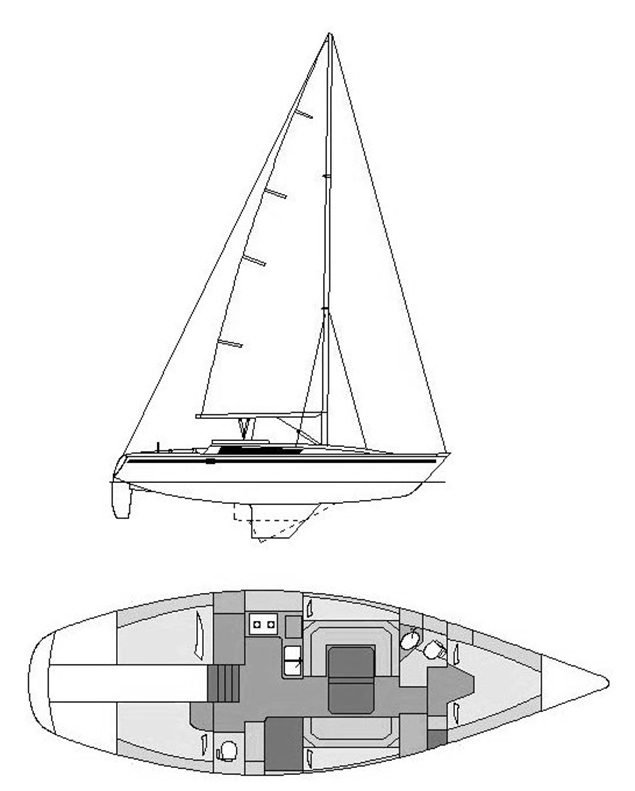 The Sun Fizz 40’s roomy accommodation can sleep six, but she’s an ideal cruising boat for up to six. The galley may seem decidedly compact, but as the large chart table has a level rather than desk-type top, it is used as an extension of the galley in port.
The Sun Fizz 40’s roomy accommodation can sleep six, but she’s an ideal cruising boat for up to six. The galley may seem decidedly compact, but as the large chart table has a level rather than desk-type top, it is used as an extension of the galley in port.
So while Robert and his old mates still took off for ten days towards Scotland at the end of May each year, they now went outside the Mull of Kintyre for a busy cruise of the nearer Hebrides, and this proved such a successful seasonal opener that other Malahide-yachts-from-Howth would join with them in some years for a mini cruise-in-company.
Aboard Mystique of Malahide, they enjoy a club-organised Cruise-in-Company provided it leaves them with plenty of space to do their own thing, and their furthest south cruise found them in the wonderful Morbihan on France’s Biscay coast after an Irish Cruising Club cruise-in-company in Brittany.
This year, the 150th Anniversary of the Royal Ulster YC on Belfast Lough provided provided a Cruise-in-Company to Scotland with the ICC and the Clyde Cruising Club, but that only got the fleet as far as Tobermory. For many this was far enough, as Scotland was experiencing it rainiest summer in many years. But the folk on Mystique of Malahide were determined to get to Skye, and though they didn’t get clear of the rain completely, they managed a clear day when anchored in the wild and mysterious Loch Scavaig in the heart of Skye’s Cuilin Mountains, and they’d another unexpectedly perfect summer’s evening at the enchanted Skye anchorage of Isle Ornsay.
 Mystique of Malahide anchored in Loch Scavaig among Skye’s Cuilin mountains which, as legend would have it, are named for Cuchulain. Photo: Lucy Michael
Mystique of Malahide anchored in Loch Scavaig among Skye’s Cuilin mountains which, as legend would have it, are named for Cuchulain. Photo: Lucy Michael
The charm of cruising is its unexpected delights, and heading south again after three days of continuous rain, a pet day came through to provide a weather window for photographer daughter Lucy to record the puffins on the Treshnish Islands west of Mull. The only other place I’ve ever seen puffins in such profusion is among the Shiant Isles up in the North Minch, yet there they seemed very wary of our little boat (she was only a 25-footer), so much so that I commented on their shyness, to which the sardonic shipmate responded that if you’d a nose like that, you’d be shy…..
Yet the crew of Mystique of Malahide found that the many puffins of Treshnish weren’t at all shy of people, as their presence meant the puffin population was temporarily protected from the usual predators such as gulls and crows. After three days of rain, the place was a hive of activity with the entire puffin population busy cleaning out their burrows, so much so that Rose was reminded of the spring cleaning season in Malahide in the old days. And now, she remembers that enchanted day with the puffins of Treshnish as the highlight of the cruise, despite the other recollections of the entertaining camaraderie of the cruise-in-company, the sheer majesty of the Cuillins, and the joys of a good sail when the weather relented.
So in joining Mystique of Malahide for the first race of the Mercedes-Benz Autumn League last Saturday afternoon afternoon, I was stepping aboard a well-loved boat which was hoping to round out a very complete season with a good final racing series. Although we raced against this Mystique with our 35-footer for many years just as previously we’d raced against the Moody 29 with our former 30-footer, it was probably the first time I’d sailed with Robert & Rose, and it was certainly interesting to see what had happened to the boat since I last examined her in detail in 1983.
Robert Michael is one of those handymen who is never happier than beavering away in his workshop at home making or improving little bits and pieces for the boat, all of which make her more comfortable, but she is still basically the same boat which, in the French style of the 1980s, can sleep ten if you really wish it, but mercifully she is provided with two toilets, so she’s an extremely civilized and comfortable boat for up to six people to go cruising, knowing that you can take more from time to time if need be.
Her rig is compact and attractively seamanlike – she has one of those forestays attached about half a metre from the masthead which very usefully prevent any tendency to spar inversion - while the lengths of her double spreaders has been carefully calculated so that they really do the job they’re required to do very well, but aren’t overlength, enabling the genoa to be set to perfection.
Philippe Briand got it right in 1980, it still looks very right, and when the breeze freshened in to the perfect strength for Mystique, our crew were determined to give of their best in the up-coming race against sixteen boats, a goodly turnout which, despite it being a non-spinnaker division, included some talented and determined helms whom we knew wouldn’t give an inch.

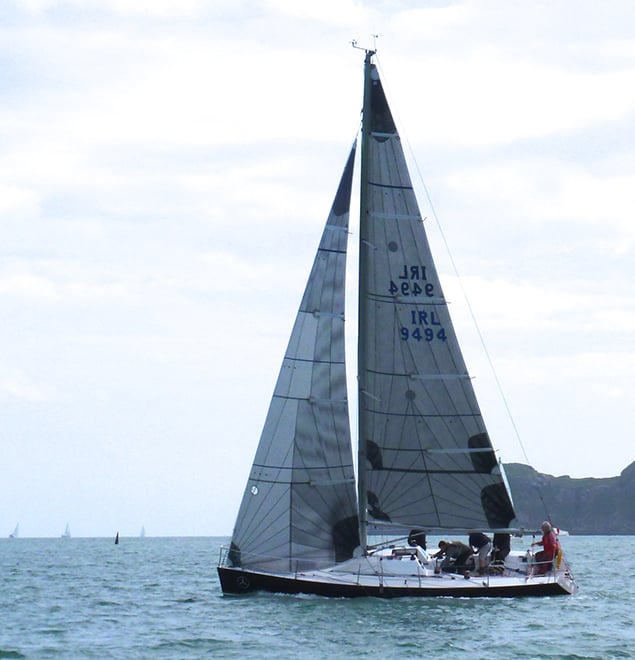
But before the start, there was the usual pre-race sociability of sailing among the fleet and saluting friends old and new, including the Galway crew with Nowhat who’d come across country to do the Howth series just as, in times past, Donal Morrissy and his Galway crew with Joggernaut contributed to so much to the East Coast’s Autumn festival
With the President of the Irish Sailing Association, no less, as Principal Race Officer on HYC’s highly individual Committee Boat, there was a sense of occasion, but the imperatives of racing took over. It could have been any start in any venue, it was the here and now that mattered, and with Colm Bermingham with his successful Elan 333 Bite the Bullet not giving us an inch of spare space, the hefty big Mystique of Malahide found herself right at the Committeee Boat very close on the line as the start sounded.

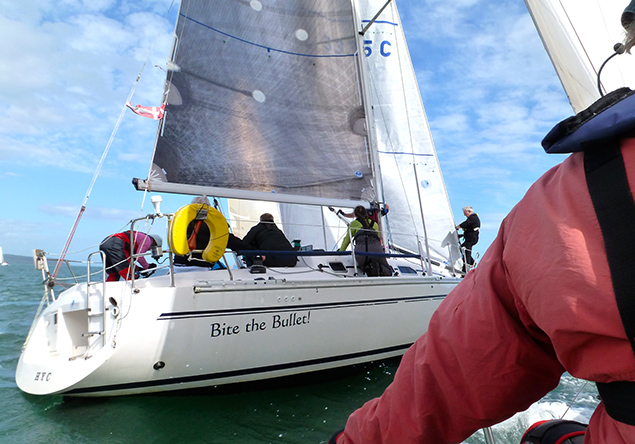
It was a start so good it was surely too good to be true, and almost immediately the recall sounded and the radio squawked: “One boat over the line”. It was something which could have been debated on board Mystique, but being minimally crewed we’d had no-one at the stemhead. The only option was taking the medicine. There was soon a gap through which we could make our escape and gybe back round the Committee Boat to re-start. Not a doddle by any means with a hefty big boat like a Sun Fizz 40, but here we were, starting again, but this time lying very sixteenth with an awful lot of work to do to get back in the races.
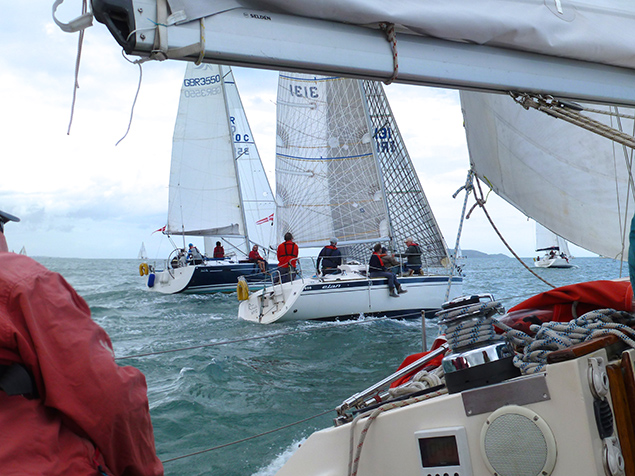
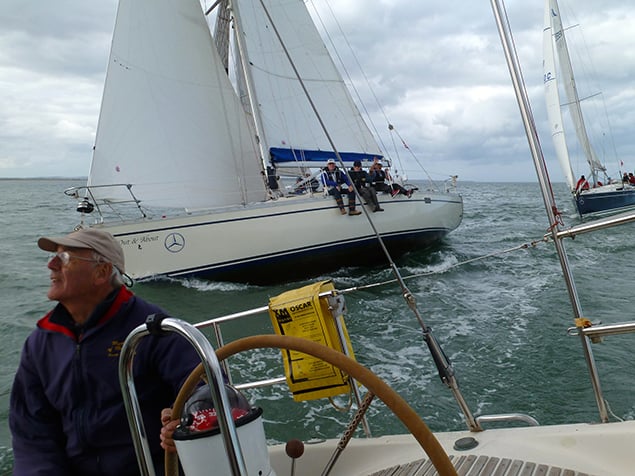
But Mystique and her helmsman did themselves and us proud. Gradually we started picking off the other boats, and in one memorably perfect mark-rounding, we took four places at a stroke. The pace intensified towards the finish as we began to get among boats we should have been racing with throughout - it was real racing with the Howth and Ireland’s Eye coastline looking its best in the returned sunshine. As we squeaked across the line to snatch sixth on the water by three seconds from Richard McAllister’s Force Five, it was with a feeling we might even be in single figures on corrected time.
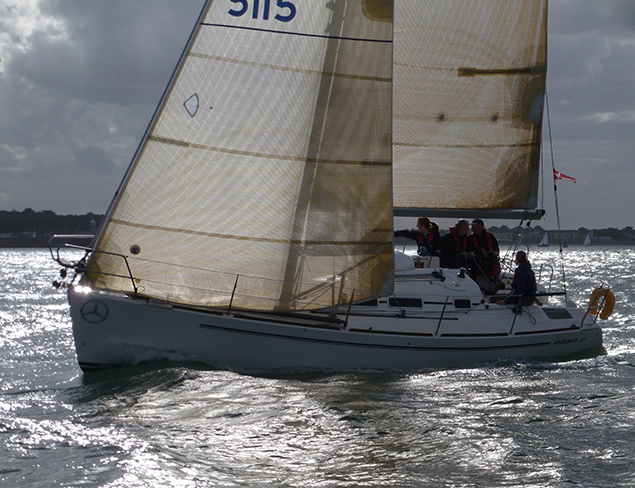

Later in the evening, we learned it was rather better than that. Although there was no way we were going to challenge Stephen Harris with the all-conquering First 40.7 Tiger which had sailed a wellnigh perfect race to win every which way from Harry Byrne’s Sunrise 34 Alphida with Dermot Skehan’s MG 345 Tough Nut third, it turned out we’d the three three sixes – sixth on the water, sixth on IRC, and sixth on ECHO.
More than reasonable in the circumstances. But as our day generally had been more than reasonable in terms of sailing enjoyment, we were in no particular hurry to get ashore to find out the actual results, and lingered over the traditional post-race sausages in the cockpit in more summery conditions than Howth has experienced for most of the supposed summer.
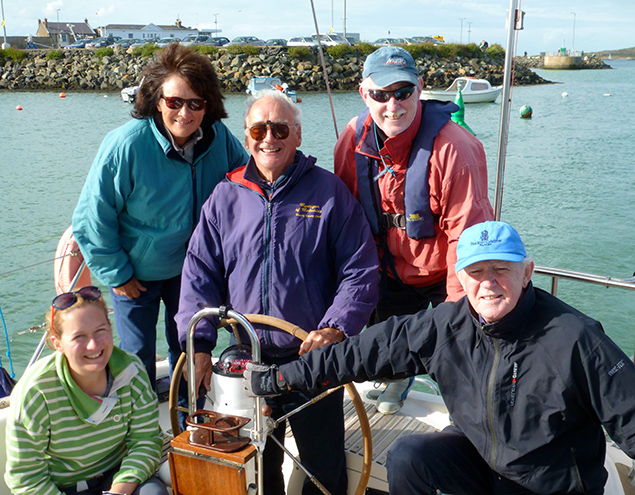


Up in the club the joint was heaving within and without, as they’d to get through all the post-race business of the first contest of the Mercedes-Benz Autumn League, and then re-focus the place entirely for the black tie ball which was to mark the final rounding out of Gary “Ted” Sargent’s epic One Wild Ride sail round Ireland in a Laser during the first part of the season, a project which has raised a truly remarkable €27,000 for ChildVision.
So with one thing and another it was Sunday evening by the time I phoned the skipper of Mystique to thank him again for Saturday’s sport and the sheer pleasure of sailing with good shipmates on a properly-used boat. We yarned of this and that, and then he closed the conversation in typically Micko style.
“Just one final thing before you go” says he. “I think you should know we weren’t actually over the line at the start. It was Terry McCoy who was OCS……”
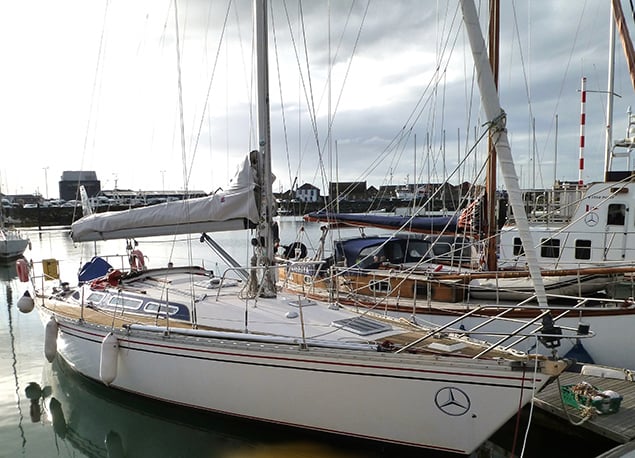
Clipper Race Watchleader Talks 'Man Overboard' At Howth YC
#ClipperRace - Howth Yacht Club will welcome Conor O'Byrne for a special talk on his experiences in the Clipper Round the World Race on Wednesday 28 September.
In particular, the watchleader on the Irish entry Derry~Londonderry~Doire will discuss his key role in the successful recovery of a crew member who fell overboard in the Pacific Ocean during the 10th stage of the 2013-14 race on 30 March 2014.
The talk begins at 7.30pm sharp. For more details see the HYC website HERE.
'Taste of Racing' Class Sets Sail At Howth Yacht Club's Autumn League
Howth Yacht Club's 37th year of its Autumn League begins this Saturday at 2:30pm and repeats each Saturday (with the exception of October 1st) until the final day on the 22nd of October.
As the entries to Howth Yacht Club's autumnal 6-week keelboat racing series still keep coming, it looks as though the weather will provide a kind window for the competitors, race management teams and sponsors MSL Park Motors and their Mercedes-Benz brand. Led by the experienced heads of Harry Gallagher and Richard Kissane, the race management team have put together a series of courses for the 6 weeks that include the option of setting Windward-Leeward races. Two fleets will be managed on separate race courses - the 'Inshore Fleet' includes the one-design classes (Squibs, Howth Seventeens, Puppeteers, Sailfleet J80s) and also Class 3. The ISA Sailfleet J80s will race in a class themselves - the 'Taste of Racing' class, which brings together many of those people who took part in the club's Adult Sail Training courses during the year and offers individuals an opportunity to mix and race with different team each week. They will be skippered by experienced and notable Howth keelboat racing–types including Noel Davidson, Fergus O'Kelly, Brian McDowell and others.
The 'Offshore Fleet' will include cruiser racing Classes 1 and 2, as well as the non-spinnaker Classes 4 and 5. Class 2 includes the club's newest assets, where up to five of the HYC J80s (and at least one notable addition in Dominic O'Keefe's J80 'Graduate' from RIYC) will compete in a class that appears to be the 'centre of gravity' for Howth keelboat racing and also includes the Half-Tonners - Harmony, Checkmate, King One and The Big Picture.
In a step away from the traditional 6-weekends-in-a-row, the event breaks for a week on October 1st - perhaps to allow sailors to get the grass cut, watch the Ryder Cup, sail in the J109 Nationals or perhaps representing their class at the ISA Senior All Ireland Sailing Championships in RCYC. But for those that won't fall into those categories, HYC will be running a 'Coastal Race' for all classes.
Howth Yacht Club's Shane Diviney is Extreme Sailing on Gazprom Team Russia
Afloat.ie caught up again with Howth Yacht Club's Shane Diviney, the only Irish sailor racing on the Extreme Sailing Series in Russia where the pro match-racer is onboard Gazprom Team Russia instead of his regular China One team.
You are here in St Petersburg racing with Gazprom Team Russia. How has that been?
I was able to join Gazprom Team Russia for the Extreme Sailing Series for the St. Petersburg Act because my usual team, China One, are not doing this event. This is Gazprom Team Russia’s debut event on the Extreme Sailing Series for 2016 and we are representing the St. Petersburg Yacht Club as the local entry for this event. I think the team has gelled really well considering we have never sailed together as a team. We have shown that we can mix it up with the more established teams on this tour. We were happy with our speed and have identified the areas where we need to improve.
You have done a few ESS events now. What is the best thing about the Series in your opinion and what is so appealing about the circuit?
The Extreme Sailing Series is the most challenging racing for the crews I have done. The race course is always so short and usually confided by numerous physical boundaries, although we do get the chance to do some open water racing at some events, which is also great. With the GC32s travelling at such high speeds you are never going in a straight line for more than a couple of minutes. This puts a big emphasis on your manoeuvres and often the teams that have the slickest and least amount of manoeuvres will be in the top 3. The highly challenging racing makes this circuit attractive to both the sailors and the spectators.
What can you tell us about the competition? Which are the strongest teams and why?
Oman Air and Alinghi have proved to be the boats to beat all season. The top teams always try to keep the racing uncomplicated and reduce the potential for error. There are always big gains to be made around the race course if you can manage to get your boat in clear air and reduce the amount of manoeuvres. This is what we have strived to achieve this week on Gazprom Team Russia here this week.
What is for you next after the St Petersburg Act?
My next regatta will be in Sotogrande (Spain) with Team Armin Strom sailing in the GC32 Racing Tour. We are currently sitting 3rd overall in that series so we will be hoping to consolidate our podium position in the final two events of the season. After this, I will hopefully be going to Lisbon for the Act 7 of the Extreme Sailing Series.
Howth Skipper Fogerty Eyes RORC IRC Prize
Having taken a substantial fifth place in the weekend's RORC Cowes to Cherbourg offshore race following on from the early season good showing in the Caribbean 600, Round Ireland and Ile D'Ouessant races, lines Conor Fogerty and the BAM crew are nicely positioned for a top three finish in the RORC IRC 3 2016 points championship.
Crew for the Cowes Cherbourg race were Conor Fogerty (Helm), Simon Knowles (Helm/Tactics), Paddy Gregory (Helm/Main Trimmer), Conor O'Neill (Main /Jib Trimmer), Julian Brexit (Trimmer), Anthony Doyle (Navigation/Bow/).
The HYC skipper and the crew took particular satisfaction in being the first Sunfast 3600 home and on IRC while also finishing ahead of a number of coveted JPK1080 yachts.
The next big outing for Fogerty and the BAM crew is the Rolex Middle Sea Race in October.
Brexit Bonus Helps Howth Yacht Club With New Keelboat Training Fleet
While the headlines and public attention for much of the summer were dominated by the acrimonious Brexit vote in Britain and the extremes of the Olympic Games in Rio de Janeiro, out beyond a narrow sandspit on a secretive peninsula east of Ireland, a special project was being finalised. This has seen the local sailing club benefit both from the Brexit fallout, and the general increased goodwill towards sailing in Ireland which Olympic success has generated. W M Nixon finds that his home-from-home of Howth Yacht Club has been doing some remarkable things while everyone else – himself included - was looking elsewhere.
You’ve heard the story about the three Howthmen who went across to England a few weeks ago to buy four J/80s, and came back with five? We hadn’t either. But all we know is that every time recently when we looked along the hard-standing on the waterfront at Howth Yacht Club, there seemed to be a couple of extra J/80s about the place. Soon there were five. And they all looked distinctly newer than the eight long-used J/80s of the SailFleet flotilla of the ISA, four of which are regularly stored out the back of the Howth club when they’re not in action.
All was revealed last weekend. The background is that Howth YC had undertaken to look after the ISA’s SailFleet flotilla of eight J/80s when the national authority began its severe slimming process three years ago. The club uses four of them at any one time in a leasing programme from the ISA for its own training purposes, but rotates the boats for their periods of non-use to implement an “equalisation process”. And of course, all eight are made available for the use of the ISA in national events like the Helmsmans Championship, wherever such events may be held.
However, since 2013 when Breda Dillon was Commodore, the Howth club has also had in place the allocation of a Sports Council capital grant for buying keelboats for training, the grant of €77,000 being conditional on HYC raising an extra €23,000 to provide a round sum of €100,000.
It was also conditional on being spent before 31st July 2016. Logic would seem to suggest that they would buy the ISA boats, four of which were on lease until 31st December 2016 anyway. But it wasn’t as simple as that. Those boats were bought with a government grant in the first place. There were all sorts of potential problems with VAT and whatever. And a bidding war against other clubs was an additional unknowable.

Yet the Howth men knew that for a multi-purpose boat which can play a key role in getting new people into sailing, or encouraging lapsed sailors back again, the J/80 was and is and will long continue to be the best boat for the job. It’s one of the very few sportsboat types which qualify for a European offshore certificate. And it is also entitled to an IRC rating. Thus in the Irish context, you can race it as a One-Design, but you are also eligible for open ICRA competition.
In addition to that, the J/80 is a very likeable knockabout boat, real fun to sail with a cockpit big enough to take significant numbers of beginners out for good yet educational times afloat, while still being a very serious racing proposition for crews of three to five. Thus the feeling in Howth was that increasing the national stock of J/80s by whatever means would be good for Irish sailing anyway.
 While the J/80 was designed primarily as a performance boat with racing a priority, in Howth they find many other uses. Photo: Brian McDowell
While the J/80 was designed primarily as a performance boat with racing a priority, in Howth they find many other uses. Photo: Brian McDowell
But though the J/80 has been a major part of the sailing scene in Europe only since a new production facility for the boat was set up in France in 2002, the design actually first appeared in America in 1992. And with the remorseless new product initiative which drives J Boats as it drives any other successful company, in late 2012 J Boats introduced the J/70, more of an outright sportsboat than the J/80, but still with a little cabin – albeit a much smaller one.
Thus for those with a taste for novelty and fashion trends, the J/70 will have been seen as the successor to the J 80. But many would reckon that the J 80 continues to be a significant brand in her own right, as she has that cherished European offshore cert. And while her cabin is minimal, it does offer significantly roomier overnight space than the J/70, as the J/80 is almost 9% larger in every way than the newer boat, an addition in size which adds a very useful bit of beef to her potential for multi-purpose functions.
That said, in the last couple of years the advent of the J/70 has tended to freeze or even reduce the price of used J/80s. For the Howthmen sitting on a war chest of €100,000 which had to be spent before the end of July 2016, the availability of top-quality used J/80s in the Solent area presented something of a dilemma. They could either enter into a lengthy tender process to take over the ISA J/80s, or else they could send an expeditionary force to the south of England to snap up four quality J/80s in a neat and clinical operation.
Four was the key number, as experience in the past three years has shown HYC that the total SailFleet flotilla of eight boats is too much for one club to handle comfortably, but anything less than four boats would be less than the required critical mass. Four boats was the absolute minimum, but as Howth YC also have two J/24s in their successful U25 Keelboat Training Squad, including the Enda O Coineen-donated Ireland’s Eye Kilcullen (Ireland’s Eye are knitwear manufacturers in nearby Baldoyle), they had some flexibility of movement in finalizing boat numbers.
In fact, in recent years the Howth club has become so dedicated to introducing people to sailing and training generally that the noted offshore racer Kieran Jameson, a General Committee member who heads the HYC key “Vessels Committee”, finds his group running a club-owned training fleet of thirty dinghies including Optimists, Toppers, 420s, and Laser Vagos. But in addition to dinghies, the Howth sailors are very strongly of the opinion that keelboats also have an important role to play in getting people started sailing, thus at any one time the club has had six “training keelboats” – the four J/80s being used at any one time plus the hotly-competed pair of J/24s – playing an active role.
The feedback from HYC Marine Manager Brian McDowell during the 2016 season has been particularly encouraging regarding the popularity of the J/80s as much for non-racing activity as for racing/training. Ireland’s many cruising enthusiasts will be delighted to hear that day cruises to places as diverse as Skerries, Dalkey Island, and Dun Laoghaire rating high on the list of favourite activities aboard J/80s amongst both younger and adult newcomers to sailing alike.
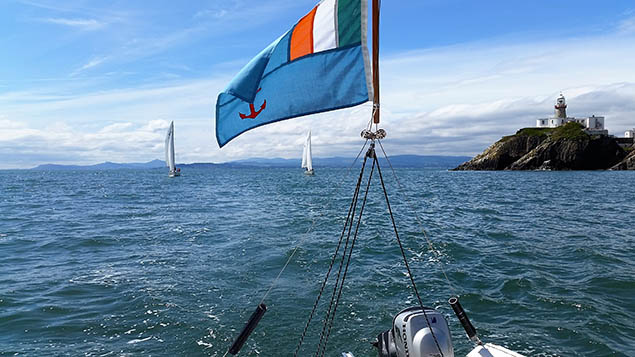 Cruising enthusiasts will be pleased to hear that trainee sailors at Howth particularly enjoy using the J/80s for cruises-in-company along the local coast. The photo above shows them returning round the Baily after a visit to Dalkey Island and Dun Laoghaire, while (below) one of the most popular destinations has been Skerries, which involves a 14 miles coastal passage with proper navigation and pilotage exercises. Photos Brian McDowell
Cruising enthusiasts will be pleased to hear that trainee sailors at Howth particularly enjoy using the J/80s for cruises-in-company along the local coast. The photo above shows them returning round the Baily after a visit to Dalkey Island and Dun Laoghaire, while (below) one of the most popular destinations has been Skerries, which involves a 14 miles coastal passage with proper navigation and pilotage exercises. Photos Brian McDowell
So acquiring the best possible J/80s within the budget was clearly the way to go. After Vice Commodore Emmet Dalton had burnt the midnight oil and the fibre optic cables in ensuring that everything in the original capital equipment grant application of 2013 was still valid, Commodore Berchmans Gannon and his committee confirmed Kieran James as “Concept and Logistics Director” with his three man “Solent Procurement Task Force”, and off they went with the 31st July deadline looming.
All this may sound very formalised, but as anyone who is familiar with Howth will know, there are times when you’ll find yourself in the midst of what seems to be a convivial gathering, yet it’s actually an open-ended official planning meeting. The club takes much of its internal communication style from its oldest class, the Howth 17s of 1898, which have managed to stay together for 117 years while apparently relying largely on telepathy for in-class information. And as all the many people involved in the J/80 acquisition programme were old friends who frequently sail together as shipmates, new ideas and understandings of how best the project might best move forward could emerge in all the most unlikely places at unexpected times.
The three man squad was imbued with enthusiasm, as Kieran Jameson is a total J/80 fan. So he already had the class’s used-boat scene sussed out in some detail in the south of England where he is well known, and with him he brought his keen sub-committee member Johnny Wormald, while third hand was a very important man when money is being spent, HYC Honorary Treasurer David Sargent.
They’d two very busy days around the Solent finalizing deals on four J/80s of the required standard in a time of financial turbulence. After the Brexit vote, the Pound Sterling had plummeted against the Euro, but their feeling (quite rightly as it turned out) was that even though it was still falling, it might be about to bounce back a bit any time soon, so there was some urgency to their work.
With no slackening of the pace, the buying job was done, and then with four boats satisfactorily secured, they were having a celebratory lunch in the RORC’s Royal Corinthian clubhouse in Cowes. But David Sargent couldn’t stop being the money man. He’d been working the screen for the numbers and the exchange rate, and in mid-meal he came up with the news that they’d hit the dealing floor on the sweet spot, in fact if they wished there was still enough in the kitty to buy a fifth boat.
Well, why not? A quick phone call home got the cheerful instruction to go right ahead. And another quick phone call ensured the fifth boat was theirs before news had spread from the Isle of Wight that three mad Irishmen were on the prowl around the Solent ready to throw good money at proper quality used J/80s.
Moving up to five boats from four may not seem such a big deal. But in fact it puts you across a significant threshold as many clubs such as Dublin Bay SC will recognize five boats as a valid class eligible for its own start, but not four. Yet thanks to Brexit, as former HYC Commodore Brian Turvey has since put it: “We landed sunny side up” – five boats and all of them good ones.
But now the challenge was to keep things moving along. Everyone had been fuelled with the excitement of the chase. Yet with high summer and its holiday plans upon them, a busy sailing programme in full swing, and the all-dominant Olympics taking over all sailing thinking for two weeks in mid-August, the challenge for all involved was to get the five boats safely back to Howth and moved into the next stage of the plan, for it was essential that the boats be in active use as soon as possible.
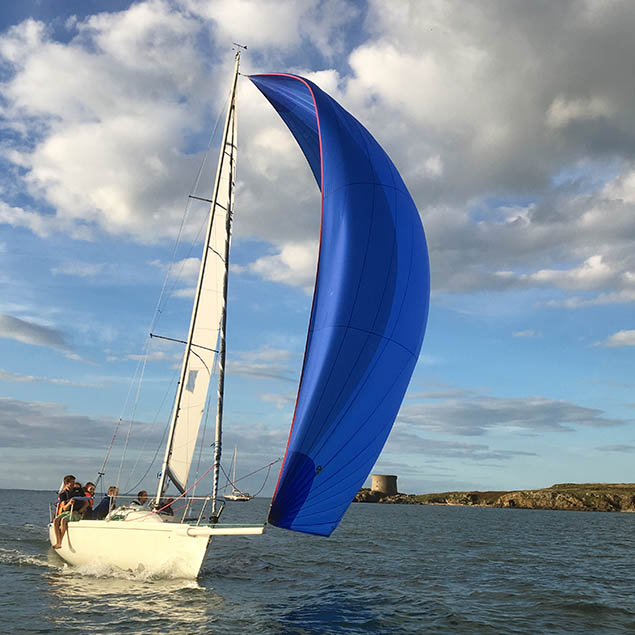
Thanks to the usual useful contacts, the boats were road-trailed to Fishguard and popped on the ferry to be taken across channel on their own to Rosslare. There, another key contact made sure they were taken safely off the ship and put in secure storage while a volunteer towing team co-ordinated by Ian Malcolm journeyed up and down the M11 from Howth until all the boats were safely on the peninsula to successfully complete a project in a league of its own for sheer value for money.
Which is fine and dandy, but the boats need to be used, and used for a lot for multiple purposes, to make this extraordinary example of club and voluntary effort worthwhile, and worthy too of the Sports Council’s support. Yet by now total serendipity had set in. Even as the newly-acquired boats were being checked over and rigged by the flotilla’s newly-appointed bo’sun Luke Malcolm, the news from the Olympic sailing in Rio got better and better. Suddenly thanks to Annalise Murphy and her team-mates, the sun was shining on Irish sailing, and there was no better time to be launching a new initiative in sailing promotion. While there’d been some concern that moving up to five boats from the projected four was maybe a bit ambitious, now people were wondering would five boats be enough.
The day after the fantastic Annalise Murphy “Welcome Home” night at the National Yacht Club, across Dublin Bay on Friday August 26th, beyond the Baily Lighthouse round in Howth Harbour the new five-strong flotilla of Howth YC’s own J/80s were in final preparation for their introduction to the membership and public with an Open Evening providing many immediate options for sailing aboard the boats. It was primarily designed with the club’s rapidly growing beginner and junior sections in mind, and as one of those perfect evenings which have blessed the late summer, it showed how well the performance-oriented J/80s lend themselves to simply being used as fun boats which can maximise the numbers getting afloat for straightforward sailing pleasure.

It also underlined the fact that at Howth as at other clubs, people such as Kieran Jameson and noted instructor Graeme Grant share the concern of leading thinkers in other clubs, that it has been too easy to let junior training and coaching take the more easily-managed route of single-handed sailing. Thus Howth has become a centre of 420 encouragement in the hope of leading on to more advanced two-handed boats, and while the J/80s were making their debut with waves of youngsters on board, on the same waters the current World 420 Bronze Medallists Doug Elmes and Colin O’Sullivan were having their first forays with their newly-acquired 49er skiff, one of a new national wave of seven 49ers with crews drawn from a number of Irish sailing centres.
But primarily it was the J/80s’ evening, and they performed with style. With the weather co-operating, the programme moved jauntily on into a junior party with early supper in the club, and then finally, with a very informally-minded audience made up of every age and interest in Howth sailing, the plans for “our very own J/80s” were at last officially revealed by Commodore Berchmans Gannon and his team.
Noted offshore racing champion Ross McDonald, as Chairman of the HYC Performance Sub-committee, left us in no doubt that while the multi-functional uses of the J/80s are significant in the new flotilla’s programme, the boats’ performance potential is also another pillar of their activities, and they’re going to be very actively raced, with their first major series the up-coming Howth Autumn League. The possibilities of sending a boat or two to major J/80 championships in the future has not been overlooked, and of course next year’s ICRA Nats at Royal Cork Yacht Club from 9th to 11th June to will be another option thanks to those very useful IRC Certs.
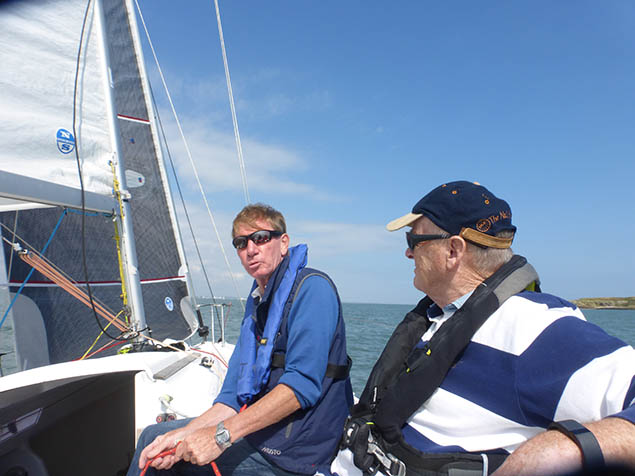
It seems an awful lot to be asking of a little fleet of five 26ft boats, but the best way to show me why it could all work very well indeed was to let me sail a J/80 on Sunday, when all was revealed. The secret of a J/80’s appeal seems to lie in the fact that she’s a boat of broad-spectrum performance and function aboard which kids feel like grown-ups, while a group of grown men start behaving like a pack of schoolboys having sailing fun.
My four ship-mates were at the heavy-hitter end of sailing’s local and national sailing administrations. They included former ICRA Commodore Nobby Reilly who has unrivalled experience in using the J/80s in Try Sailing events – he regularly gets turnouts of upwards of 80 total newbies at such happenings – there was also HYC Vice Commodore Emmet Dalton who somehow finds himself to be the owner of a foiling Moth and the skipper of a Howth 17, there was of course Kieran Jameson whose devotion to sailing and it development and promotion is lifelong, and there was also former HYC Commodore Brian Turvey who has been the club’s liaison man in handling relations with the ISA SailFleet administration while coming to the conclusion that the only way forward was for Howth to buy its own fleet of J/80s to give the programme an extra and vital element of direct proprietorial pride, something which has been achieved.

So in sailing “our” J/80 in a glorious burst of sunshine and a grand little north to nor’east breeze last Sunday while the HYC Junior Dinghy regatta with 90 boats in several classes proceeded apace nearby, and Doug Elmes and Colin O’Sullivan buzzed over the ocean towards the northern horizon in their 49er, we had ourselves a ball. While you can certainly get sensational speeds out of a J/80 when the breeze is stonking, we’d no bother in that pleasant moderate wind of finding 7.6 knots through the water with genniker set, and as that translated into 8.7 SOG thanks to a favourable tide, the schoolboy glee was much in evidence between sessions of serious information exchange about the importance of the boat in Howth’s development programe.
In such sailing conditions, the J/80’s effortless progress made it possible for us to get quicky up to Malahide and then have some sport carrying the genniker as close as it could go to get us round Ireand’s Eye where the gannets are more crowded than ever on the Stack, and back into Howth Marina with the J/80s manoeuvring capacities being demonstrated with a flourish.
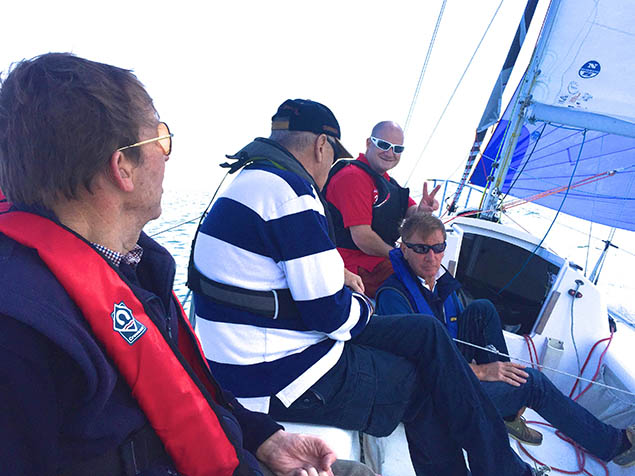
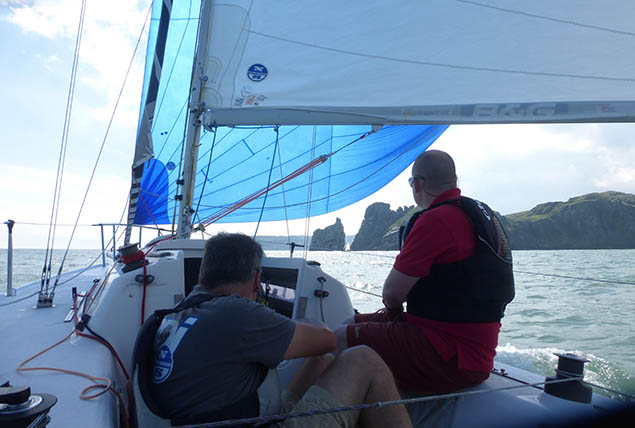
Of course, it won’t always be a sunny nor’easterly of very manageable strength, and it won’t always be a time when a club can look back on its own good season while sharing the national mood of euphoria over an Olympic Sailing Silver Medal. But this new J/80 project at Howth has a lot going for it. And when you start looking at the figures which would have come up if they’d ordered new boats, or maybe even new J/70s, through the formal channels, you’re very quickly getting away from €100,000 for five boats, and approaching the region of a quarter million euros.
But for the times that are in it, it seems that Howth took the best approach. In fact, when the boats are going to have such a multi-functional role, it’s surely better to start with the best second-hand boat available rather than a brand new one. When knockabout use is part of the programme, evidence of the occasional little scape or minor bump makes the boats seem less daunting.
So in all, it has been a very good six weeks of voluntary work. But out in Howth, they don’t see it that way. As far as they’re concerned, the work is only beginning. If those boats aren’t all being kept very busy, steps will be taken immediately to accelerate the pace.
 Home port, and everyone gives a hand. Former HYC Commodore Brian Turvey and former ICRA Commodore Nobby Reilly stow the J/80’s mainsail while above on the forecourt the presence of the 1898-built Howth 17 Rita is a reminder of HYC’s long and colourful history. Photo: W M Nixon
Home port, and everyone gives a hand. Former HYC Commodore Brian Turvey and former ICRA Commodore Nobby Reilly stow the J/80’s mainsail while above on the forecourt the presence of the 1898-built Howth 17 Rita is a reminder of HYC’s long and colourful history. Photo: W M Nixon



























